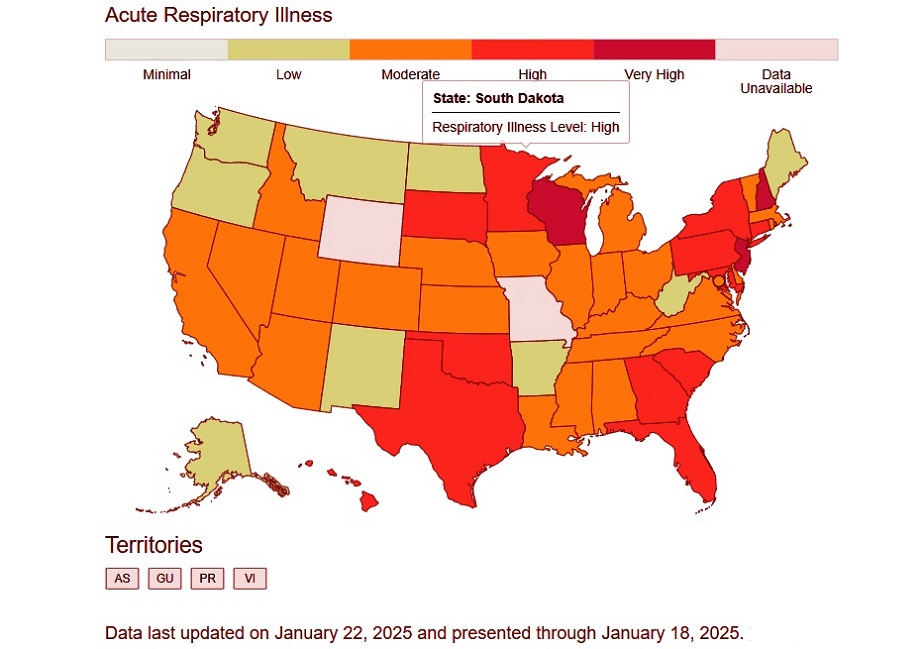Nikhil Prasad Fact checked by:Thailand Medical News Team Jan 26, 2025 10 months, 3 weeks, 5 days, 22 hours, 26 minutes ago
U.S. Medical News: The latest data released by the U.S. Centers for Disease Control and Prevention (CDC) paints a concerning picture of respiratory illness trends across the United States. As of January 24, 2025, the national influenza positivity rate has surged to 25 percent, reflecting a significant rise in cases. This increase comes as part of a broader wave of respiratory infections that includes COVID-19 and respiratory syncytial virus (RSV), both of which are also contributing to the burden on the healthcare system.
 Influenza Positivity Rates Hit 25 Percent Across the United States
Influenza Positivity Rates Hit 25 Percent Across the United States
Image Credit: U.S. CDC
According to the U.S. CDC’s weekly update, emergency department visits and hospitalizations for influenza have reached alarming levels in many states. While RSV appears to have peaked in much of the country, COVID-19 activity is also on the rise, although not at the same pace as influenza. This
U.S. Medical News report explores the current state of respiratory illnesses in the U.S., focusing on influenza’s dominance and its implications for public health.
Rising Trends in Respiratory Illnesses
Respiratory illnesses, including the flu, RSV, and COVID-19, are driving millions of Americans to seek medical care. The U.S. CDC reports that emergency department visits for influenza are currently at very high levels, while RSV’s impact has begun to wane in many areas. COVID-19 emergency visits and hospitalizations, though comparatively lower, are still a cause for concern, particularly among older adults and young children.
Seasonal flu activity is described as “elevated” nationwide, with New Jersey, New Hampshire, Wisconsin and Hawaii being some of the hardest-hit states. The positivity rate for influenza tests has climbed to 25 percent, an indication of widespread community transmission. Meanwhile, the positivity rates for COVID-19 and RSV remain steady at 6.2 percent and 8.8 percent, respectively. Despite this, the combination of all three viruses is placing a significant strain on hospitals, particularly in regions where vaccination coverage is low.
https://www.cdc.gov/respiratory-viruses/data/activity-levels.html
https://www.cdc.gov/respiratory-viruses/data/index.html
Who Is Most Affected?
The demographic breakdown of hospitalizations reveals that the flu is particularly impacting older adults aged 65 and above. This age group is seeing the highest hospitalization rates, followed by children under the age of four. For the youngest children, RSV remains a significant driver of emergency department visits, alongside influenza. Pediatric flu deaths have also become a grim statistic this season, with at least 27 reported, including 11 in the last week alone.
COVID-19, while not at its previous peak levels, continues to pose risks for vulnerable populations. Hospitalization and death rates remain highes
t among older adults, with a current COVID-19 mortality rate of 1.4 percent. Influenza’s mortality rate is close behind at 1.2 percent, underscoring the virus’s severity this season.
https://www.cdc.gov/respiratory-viruses/data/illness-severity.html
Wastewater Data and Virus Predictions
The CDC’s wastewater surveillance provides additional insights into viral activity. Influenza A’s levels in wastewater are categorized as “high” nationwide, while COVID-19 and RSV levels are described as “moderate.” Wastewater data is a critical tool for tracking virus circulation, especially since it captures infections even in individuals who may not seek medical care.
Looking ahead, the CDC’s predictive models suggest that emergency department visits for influenza will remain high and are expected to increase in most states. COVID-19 emergency visits, in contrast, are predicted to stay relatively low compared to previous winter seasons. However, public health officials caution that this respiratory virus season is the first in several years to align with pre-pandemic patterns, which historically have included secondary peaks in activity.
Public Health Measures
Public health experts recommend continued adherence to preventive measures, such as frequent handwashing, wearing masks in crowded indoor settings, and staying home when sick. These steps can help reduce the transmission of respiratory viruses and protect vulnerable populations.
The Human Impact
The current wave of respiratory illnesses is not just a statistical phenomenon; it is affecting real lives across the country. Families are grappling with the challenges of caring for sick children, older adults, and immunocompromised individuals.
Emergency departments and healthcare workers are under immense pressure as they manage the influx of patients. Meanwhile, businesses and schools are also feeling the strain, with high levels of absenteeism disrupting daily operations.
For those directly impacted, the consequences can be devastating. Hospitalized patients face long recovery periods, and families who lose loved ones to these illnesses endure immeasurable grief. The rising death toll, particularly among children and older adults, serves as a stark reminder of the importance of preventive measures and timely medical care.
Conclusion
As the U.S. battles a surge in respiratory illnesses, the flu has emerged as the most significant driver of healthcare utilization. With a 25 percent positivity rate and rising hospitalizations, influenza is causing widespread concern among public health officials and the general population. COVID-19 and RSV, while less dominant, continue to pose risks, particularly for vulnerable groups.
The U.S. CDC’s data highlights the critical need for increased vaccination coverage and adherence to preventive measures to mitigate the impact of these viruses. Public health experts also stress the importance of staying informed and seeking medical care when necessary.
For the latest
U.S. Medical News, keep on logging to Thailand Medical News.
Read Also:
https://www.thailandmedical.news/news/h5n1-bird-flu-vaccines-are-accelerating-viral-evolution-as-currently-observed-in-china
https://www.thailandmedical.news/news/usda-and-aphis-warns-of-more-domestic-cats-getting-infected-with-h5n1-in-the-united-states
https://www.thailandmedical.news/articles/influenza-or-flu
https://www.thailandmedical.news/articles/h5n1-avian-flu
